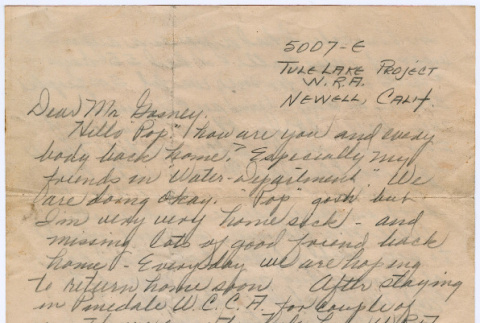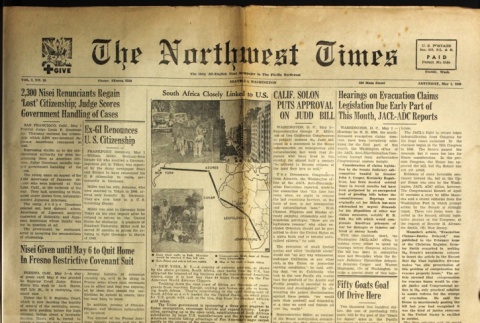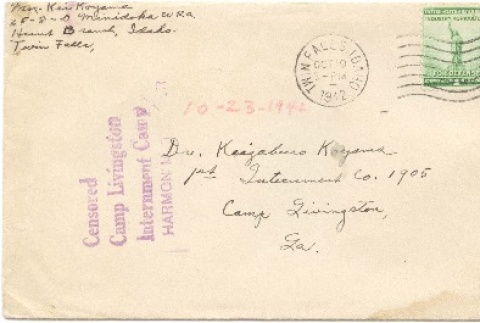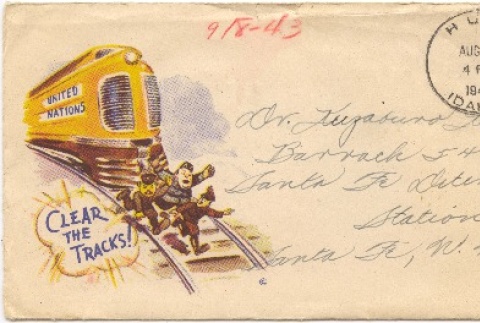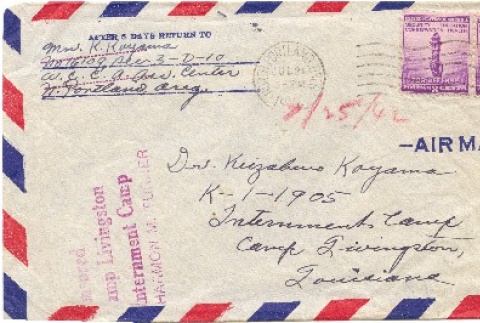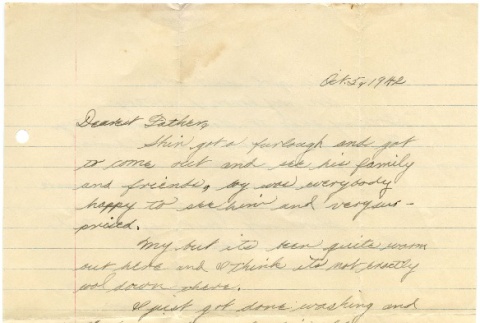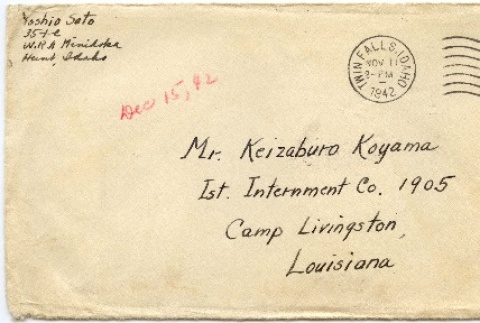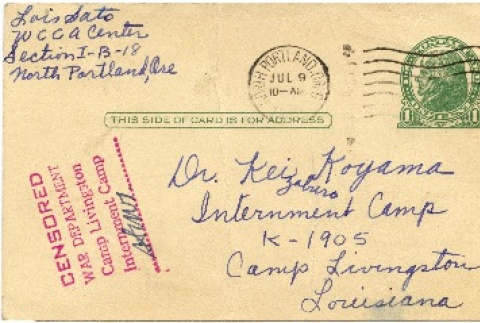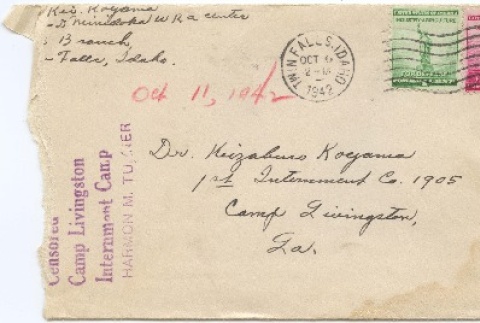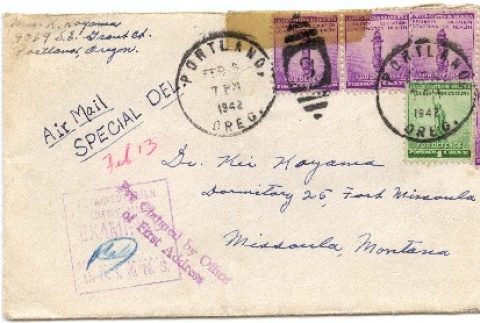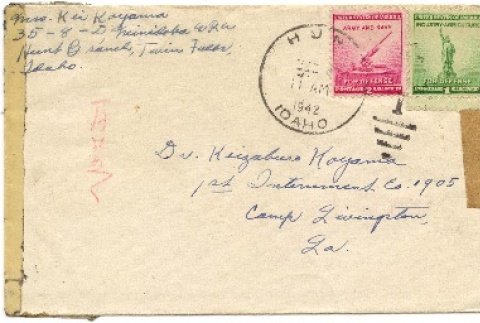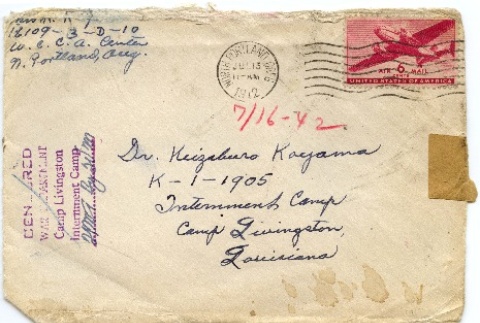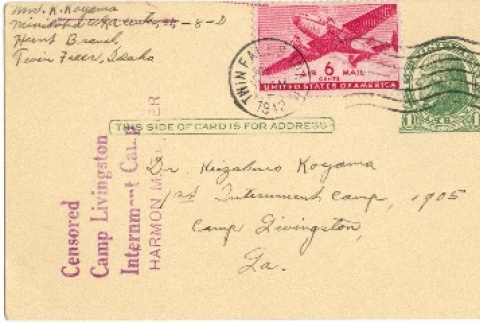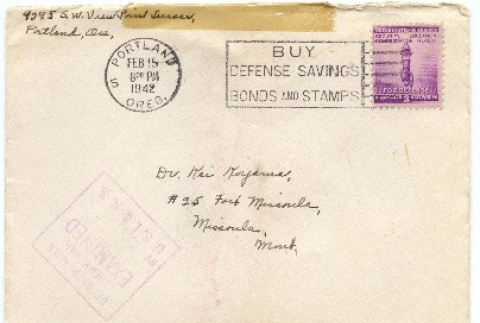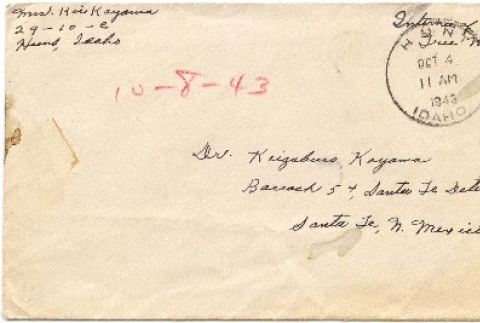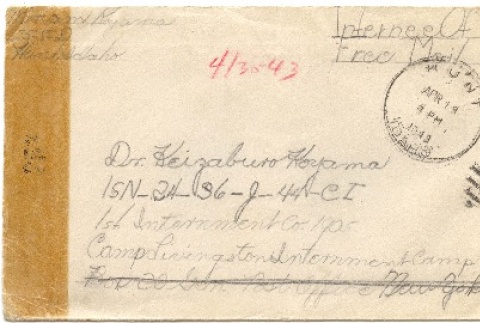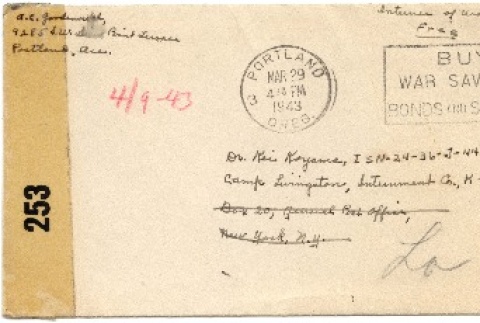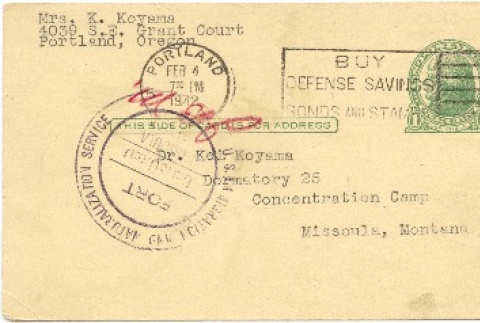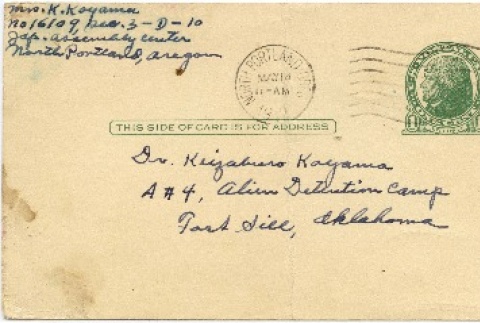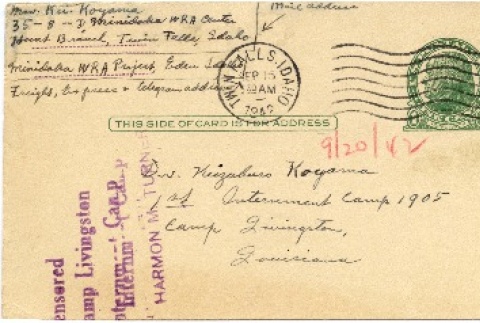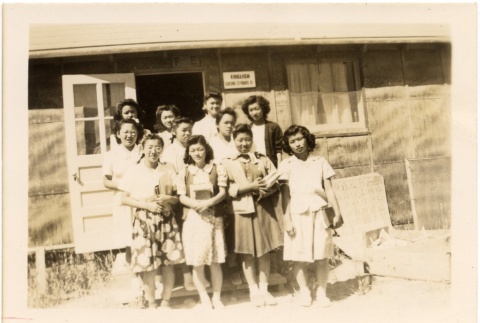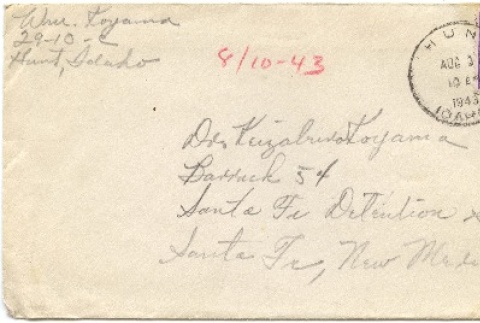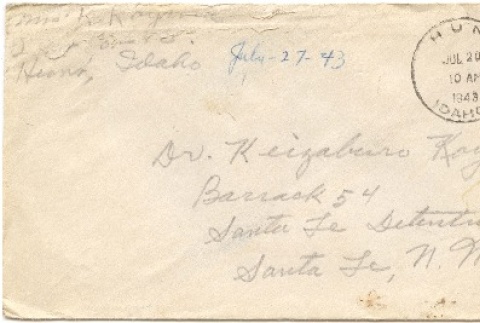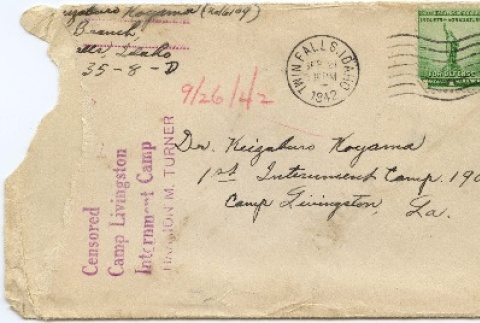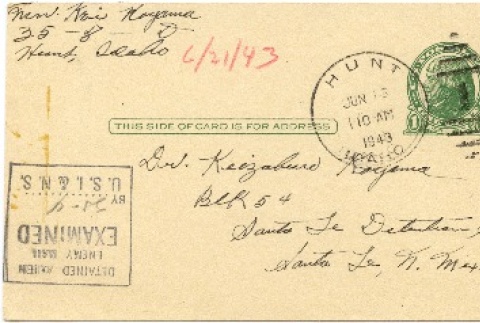Impact of incarceration
World War II
(231)
Concentration camps
(1434)
Impact of incarceration
(343)
Related articles from the
Densho Encyclopedia :
Stanley Hayami,
Joe Kobuki,
Manzanar Children's Village,
Richard S. Nishimoto,
Tamotsu Shibutani,
Tamie Tsuchiyama
343 items
343 items
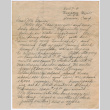
doc
Letter to Benjamin Coleman Gosney from Tomio Itabashi (ddr-densho-455-1)
Tomio Itabashi describes his time at Pinedale and his move to Tule Lake.
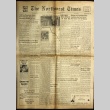
doc
The Northwest Times Vol. 2 No. 38 (May 1, 1948) (ddr-densho-229-106)
"2,300 Nisei Renunciants Regain "Lost' Citizenship; Judge Scores Government Handling of Cases" (p. 1), "Hearings on Evacuation Claims Legislation Due Early Part of This Month, JACL-ADC Reports" (p. 1),
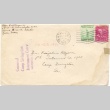
doc
Envelope and letter to Dr. Keizaburo "Kei" Koyama from Teru Koyama (ddr-one-5-40)
Slightly yellowed envelope addressed to Dr. Keizaburo Koyama in Camp Livingston from his wife, Teru Koyama, at Minidoka. Postmarked October 19, 1942. Along the top 10-23-1942 is written in red pencil. On the left side of the envelope is a purple "Censored" stamp. Inside the envelope is a letter dated October 17, 1942. Teru writes about …
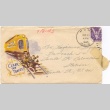
doc
Envelope and letter to Dr. Keizaburo "Kei" Koyama from Eva Koyama (ddr-one-5-67)
Envelope addressed to Dr. Keizaburo Koyama in Santa Fe Detention Center. The envelope is postmarked August 30, 1943. Written in red pencil along the top of the envelope is “9/8-43.” On the left side of the envelope is a cartoon drawing of a yellow train with the words “United Nations” in blue on the side the …
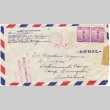
doc
Envelope and letters to Dr. Keizaburo "Kei" Koyama from Teru Koyama (ddr-one-5-20)
White air mail envelope with a red, white and blue border. The envelope is addressed to Dr. Keizaburo Koyama at Camp Livingston from his wife, Teru Koyama. The envelope is postmarked Jul 21, 1942, and in red pencil below the postmark is the date 7/25/42. On the left side of the envelope is a purple "Censored" …
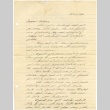
doc
Letter to Dr. Keizaburo "Kei" Koyama from Eva Koyama (ddr-one-5-38)
Letter dated Oct 5, 1942, to Keizaburo "Kei" Koyama from his daughter, Eva Koyama. In the letter Eva writes about life at Minidoka: Shin came to visit, school is starting soon, Mr. Mita's funeral, lunch, and Girl Scouts. Eva sends her regards to Dr. Tanaka and Mr. Ikeya.

doc
Envelope and letter to Dr. Keizaburo "Kei" Koyama from Yoshi Sato (ddr-one-5-42)
Envelope addressed to Mr. Keizaburo Koyama at Camp Livingston from Yoshio Sato at Minidoka. Postmarked November 11, 1942. In red pencil “Dec 15, 42” is written. Along the right edge of the envelope is a white sticker, on the back side of the envelope it reads "U.S.A. 269." Inside the envelope is a letter dated Nov. …
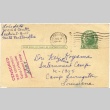
doc
Postcard to Dr. Keizaburo "Kei" Koyama from Lois Sato (ddr-one-5-18)
Postcard addressed to Dr. Keizaburo Koyama at Camp Livingston from Lois Sato at the Portland Assembely Center. Postmarked Jul 9, 1942. On the left side of the front of the postcard is a red Censored stamp with an unknown signature. On the back of the postcard is a handwritten message from Lois Sato. She writes about …

doc
Envelope and letters to Dr. Keizaburo "Kei" Koyama from Teru Koyama and Miriam Koyama (ddr-one-5-37)
Envelope addressed to Dr. Keizaburo Koyama at Camp Livingston from his wife, Teru Koyama, and daughter, Miriam Kiyo Koyama. Postmarked October 6, 1942. To the left of the postmark “Oct 11, 1942,” is written in red pencil. On the left side of the envelope is a purple "Censored" stamp from Camp Livingston. Inside the envelope are …

doc
Envelope and letter to Dr. Keizaburo "Kei" Koyama from Teru Koyama (ddr-one-5-7)
Yellowed envelope addressed to Dr. Kei Koyama at Fort Missula with two postmarks from Portland; dated February 6, 1942. Handwritten is “Air Mail/SPECIAL DEL.” on the left side of the envelope; in red pencil “Feb 13” is written below. There are two purple stamps in the lower left corner: one is a "Fee" stamp from the …

doc
Envelope and letter to Dr. Keizaburo "Kei" Koyama from Teru Koyama (ddr-one-5-45)
Envelope addressed to Dr. Keizaburo Koyama at Camp Livingston from his wife, Teru Koyama, at Minidoka. Postmarked Dec 8, 1942. There is clear tape along the whole left edge. Japanese is written on the left side of the envelope. On the back of the envelope is a purple "RECEIVED" stamp with the date Jan 24, 1943. …
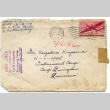
doc
Envelope and letter to Dr. Keizaburo "Kei" Koyama from Teru Koyama and Eva Koyama (ddr-one-5-19)
Yellowed envelope addressed to Dr. Keizaburo Koyama in Camp Livingston from his wife, Teru Koyama, in the Portland Assembly Center. The envelope is postmarked Jul 13, 1942. In red pencil “7/16-42” is written just below the postmark. On the left side of the envelope is a purple "CENSORED" stamp with unknown initials below the stamp in …
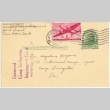
doc
Postcard to Dr. Keizaburo "Kei" Koyama from Teru Koyama (ddr-one-5-35)
Front of one cent postcard is addressed to Dr. Keizaburo Koyama at Camp Livingston from his wife, Teru Koyama, at Minidoka. Postmarked Oct. 1942 over a six cent airmail stamp. On the left side of the front of the postcard is a purple "Censored" stamp. The message on the back of the postcard is dated Sept. …

doc
Envelope and letter to Dr. Keizaburo "Kei" Koyama from Andrew "Uncle Chape" Goodenough and Eva "Aunt Eva" Goodenough (ddr-one-5-8)
Envelope addressed to Dr. Kei Koyama at Fort Missula from Andrew "Uncle Chape" Goodenough and Eva "Aunt Eva" Goodenough. Postmarked Feb 15, 1942. In the lower left corner is an "EXAMINED" stamp. Inside is a letter folded like a card with an "EXAMINED" stamp over the crease; dated February 15, 1942. The letter encourages Kei to …

doc
Envelope and letter to Dr. Keizaburo "Kei" Koyama from Teru Koyama (ddr-one-5-72)
Envelope addressed to Dr. Keizaburo Koyama at the Santa Fe Detention Station from his wife, Teru Koyama, at Minidoka. Postmarked Oct 4, 1943. In the upper right corner “Internee of War/Free Mail” is written in place of a stamp. The numbers “10-8-43” are written along the top of the envelope in red pencil. Inside is a …

doc
Envelope and letter to Dr. Keizaburo "Kei" Koyama from Miriam Kiyo Koyama (ddr-one-5-52)
Envelope addressed to Dr. Keizaburo Koyama at Camp Livingston from his daughter, Miriam Kiyo Koyama, at Minidoka. In place of postage “Internee of War/Free Mail” is written in the upper right hand corner. Postmarked Apr. 18, 1943. In the upper center of the envelope “4/30-43” is written in red pencil. Along the left edge of the …

doc
Envelope and letter to Dr. Keizaburo "Kei" Koyama from Andrew "Uncle Chape" Goodenough and Eva "Aunt Eva" Goodenough (ddr-one-5-49)
Envelope addressed to Dr. Kei Koyama at Camp Livingston from A.C. Goodenough (Andrew "Uncle Chape" Goodenough) in Portland. Postmarked Mar 29, 1943. In place of postage “Internee of War mail/Free” is written in the upper right corner. Written on the left side of the postmark is “4/9-43” in red pencil. Along the left edge of the …
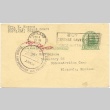
doc
Postcard to Dr. Keizaburo "Kei" Koyama from Teru Koyama (ddr-one-5-6)
One cent postcard addressed to Dr. Kei Koyama at Fort Missoula from his wife, Teru Koyama, in Portland. The address on the front of the postcard is typed. Postmarked Feb 4, 1942. Censored stamp on the front, with an unknown signature in red pencil. Typed message on the back updates Kei about the children, her health, …

doc
Postcard to Dr. Keizaburo "Kei" Koyama from Teru Koyama (ddr-one-5-12)
One cent postcard addressed to Dr. Keizaburo Koyama at Fort Sill from his wife, Teru Koyama, at the Portland Assembly Center. Postmarked May 14, 1942. Message on the back dated May 13, 1942. Teru writes to Kei about her and the children getting their first typhoid shots, her new work duties, and the family's enjoyment of …

doc
Postcard to Dr. Keizaburo "Kei" Koyama from Teru Koyama (ddr-one-5-29)
One cent postcard addressed to Dr. Keizaburo Koyama at Camp Livingston from his wife, Teru Koyama, at Minidoka. The return sender information has both a mailing and telegram address listed. Postmarked Sep. 15, 1942. Below the postmark “9/20/42” is written in red pencil. On the left side of the postcard is a purple "Censored" stamp. The …
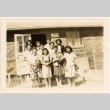
img
Minidoka Classmates (ddr-one-5-68)
Black and white photographic print of 11 girls standing outside a barrack at Minidoka posing for a picture. Three girls in the foreground are holding books.

doc
Envelope and letter to Dr. Keizaburo "Kei" Koyama from William Koyama (ddr-one-5-64)
Envelope addressed to Dr. Keizaburo Koyama in Santa Fe Detention Center from his son, William Koyama, at Minidoka. Envelope is postmarked August 3, 1943. In red pencil "8/10-43" is written above the receiver's information. The letter from William Koyama is yellowed and water-damaged. At the bottom of the letter is an "EXAMINED" stamp with unknown initals. …

doc
Envelope and letter to Dr. Keizaburo "Kei" Koyama from Teru Koyama (ddr-one-5-61)
Envelope addressed to Dr. Keizaburo Koyama at Santa Fe Detention Station from his wife, Teru Koyama, at Minidoka. Postmarked Jul 20, 1943. At the top of the envelope “July-27-43” is written in blue pencil. Inside the envelope is a letter written by Teru dated July 18, 1943, in which she quotes a long poem by an …

doc
Envelope and letters to Dr. Keizaburo "Kei" Koyama from Teru and Eva Koyama (ddr-one-5-33)
Envelope addressed to Dr. Keizaburo Koyama at Camp Livingston from his wife, Teru Koyama, and daughter, Eva Koyama. Postmarked Sep 21, 1942. To the left of the postmark is “9/26/42” written in red pencil. On the left side of the envelope is a purple "Censored" stamp. The left edge of the envelope is torn so that …

doc
Postcard to Dr. Keizaburo "Kei" Koyama from Teru Koyama (ddr-one-5-56)
One cent postcard addressed to Dr. Keizaburo Koyama at Santa Fe Detention Station from his wife, Teru Koyama, at Minidoka. Postmarked Jun 15, 1943. To the left of the postmark “6/21/43” is written in red pencil. In the lower left corner is an upside down "Examined" stamp. The back of the postcard is dated June 14, …
